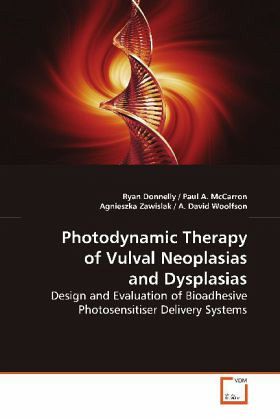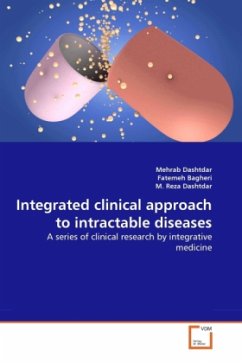
Photodynamic Therapy of Vulval Neoplasias and Dysplasias
Design and Evaluation of Bioadhesive Photosensitiser Delivery Systems
Versandkostenfrei!
Versandfertig in 6-10 Tagen
52,99 €
inkl. MwSt.

PAYBACK Punkte
26 °P sammeln!
This book describes the design, physicochemical characterisation and clinical evaluation of bioadhesive drug delivery systems for photodynamic therapy of difficult-to-manage vulval neoplasias and dysplasias. In photodynamic therapy (PDT), a combination of visible light and a sensitising drug causes the destruction of selected cells. ALA is commonly delivered to the vulva using creams or solutions, which are covered with an occlusive dressing to aid retention and enhance drug absorption. Such dressings are poor at staying in place at the vulva, where shear forces are high in mobile patients. To...
This book describes the design, physicochemical
characterisation and clinical evaluation of
bioadhesive drug delivery systems for photodynamic
therapy of difficult-to-manage vulval neoplasias and
dysplasias. In photodynamic therapy (PDT), a
combination of visible light and a sensitising drug
causes the destruction of selected cells. ALA is
commonly delivered to the vulva using creams or
solutions, which are covered with an occlusive
dressing to aid retention and enhance drug
absorption. Such dressings are poor at staying in
place at the vulva, where shear forces are high in
mobile patients.
To overcome the problems associated with delivery of
ALA to the vulva, we produced a bioadhesive patch
by a novel laminating procedure. The ALA loading was
38 mg cm-2. Patches were shown to release more ALA
over 6 hours than the proprietary cream. The ALA
concentration in tissue at 2.375 mm was an order of
magnitude greater than that found to be cytotoxic to
HeLa cells. Clinically, the patch was used in
successful PDT of vulval intraepithelial neoplasia,
lichen sclerosus, squamous hyperplasia, Paget s
disease and vulvodynia.
characterisation and clinical evaluation of
bioadhesive drug delivery systems for photodynamic
therapy of difficult-to-manage vulval neoplasias and
dysplasias. In photodynamic therapy (PDT), a
combination of visible light and a sensitising drug
causes the destruction of selected cells. ALA is
commonly delivered to the vulva using creams or
solutions, which are covered with an occlusive
dressing to aid retention and enhance drug
absorption. Such dressings are poor at staying in
place at the vulva, where shear forces are high in
mobile patients.
To overcome the problems associated with delivery of
ALA to the vulva, we produced a bioadhesive patch
by a novel laminating procedure. The ALA loading was
38 mg cm-2. Patches were shown to release more ALA
over 6 hours than the proprietary cream. The ALA
concentration in tissue at 2.375 mm was an order of
magnitude greater than that found to be cytotoxic to
HeLa cells. Clinically, the patch was used in
successful PDT of vulval intraepithelial neoplasia,
lichen sclerosus, squamous hyperplasia, Paget s
disease and vulvodynia.












